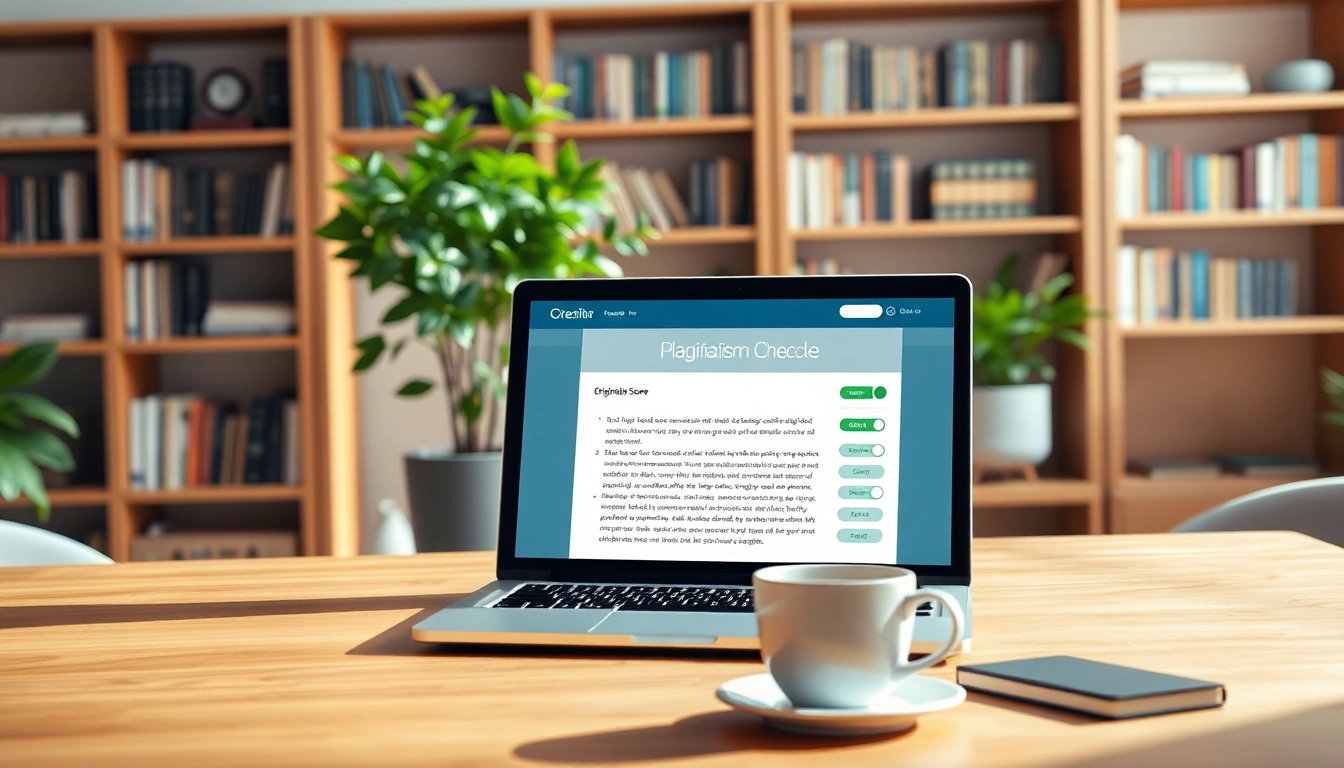Understanding Plagiarism and Its Consequences
In academic and professional contexts, plagiarism can be a serious offense with repercussions that can affect an individual’s career and reputation. To safeguard intellectual integrity, it’s crucial to grasp the nuances of plagiarism and the significance of plagiarism detectors. This article delves into everything from the definition of plagiarism to the tools that help maintain originality in written works.
What is Plagiarism?
Plagiarism is the act of using someone else’s work or ideas without proper attribution, presenting them as one’s own. It can occur in various forms, from verbatim copying of text to less obvious acts like reproducing ideas without credit. In academia, this can lead to expulsion or retraction of published work, while in the professional realm, it can damage reputations and careers.
Types of Plagiarism
Understanding the different types of plagiarism is fundamental for anyone engaging in writing or content creation:
- Direct Plagiarism: Copying text word-for-word without quotation or citation.
- Self-Plagiarism: Reusing one’s previous work without acknowledgment in new submissions.
- Paraphrasing Plagiarism: Rephrasing someone’s ideas or text without giving credit.
- Mosaic Plagiarism: Mixing phrases or ideas from various sources without proper attribution.
- Accidental Plagiarism: Unintentional misuse of sources due to ignorance or misunderstanding of citation rules.
The Impact of Plagiarism on Academic and Professional Integrity
The consequences of plagiarism can vary significantly based on context:
- Academic Consequences: Students caught plagiarizing may face disciplinary actions ranging from failing grades to expulsion. This impacts academic records, scholarships, and future educational opportunities.
- Professional Consequences: In the workplace, plagiarism can lead to termination, damage to personal credibility, and legal implications, including copyright lawsuits.
- Intentional vs. Unintentional: While knowingly committing plagiarism is viewed as unethical, accidental plagiarism can also result in serious repercussions, highlighting the importance of understanding and respecting established rules of attribution.
How a Plagiarism Detector Works
Plagiarism detection tools have evolved significantly with advancements in technology. Understanding the mechanics and capabilities of these tools helps ensure effective utilization and maximum protection against unintentional plagiarism.
Technical Insights: Algorithms Behind Plagiarism Detection
At the heart of any plagiarism detector lies complex algorithms and databases.
- Text Comparison: Plagiarism detectors typically employ string-matching algorithms to identify similarities between the submitted text and existing literature across vast databases.
- Semantic Analysis: Some advanced tools utilize semantic analysis to detect paraphrased content by understanding meaning rather than merely comparing text strings.
- Machine Learning: By leveraging machine learning, modern plagiarism detectors can improve their accuracy by learning from previous scans and user corrections, adapting to new patterns of writing and citation.
- Source Indexing: Many tools access extensive databases of published works, academic papers, and internet resources to provide a thorough scan for matching or similar content.
Features to Look for in a Plagiarism Detector
Choosing an effective plagiarism detector is crucial for maintaining originality in writing. Key features to consider include:
- Comprehensive Database: The tool should have access to a wide range of sources, including academic papers, websites, and books, to ensure thoroughness.
- Real-Time Scanning: Instant results are more effective for immediate corrections in writing.
- User-Friendly Interface: Tools should be easy to navigate, providing clear reports and suggestions for citation.
- File Format Compatibility: A good plagiarism detector should support various file formats (e.g., PDF, DOCX).
- Detailed Reporting: The ability to generate comprehensive reports detailing the nature of detected plagiarism increases usability.
Limitations and Challenges of Detection Tools
Despite numerous advantages, plagiarism detectors are not infallible. Various challenges and limitations exist:
- False Positives: High similarity scores may not always indicate plagiarism; common phrases or terminology can trigger alerts.
- Database Limitations: Some tools may not cover all possible sources, leading to undetected plagiarism.
- Contextual Understanding: Many tools do not accurately assess the context of the text, potentially mislabeling legitimate citations.
- Cost: Some robust tools come with a price tag, which can be a barrier for students and individuals.
Choosing the Right Plagiarism Detector
Selecting the appropriate plagiarism detection tool involves evaluating various factors to meet distinct needs effectively.
Comparison of Free and Paid Plagiarism Detection Tools
Free tools can be appealing, especially for students or anyone on a budget. However, there are critical differences between free and paid options that can affect effectiveness:
- Accuracy: Paid detectors tend to be more reliable in identifying a wider range of plagiarism scenarios, often employing more sophisticated technology.
- Database Size: While free tools may restrict database access, paid versions generally offer comprehensive scans across more sources.
- User Support: Paid tools usually come with customer support services to assist users in troubleshooting issues or understanding reports.
- Features: Premium options frequently offer more advanced features, such as integration with writing platforms, citation assistance, and more detailed analytics.
User Reviews and Recommendations
User reviews and recommendations can provide insight into real-world efficacy and user experience with different plagiarism detectors. Others’ experiences may highlight:
- Reliability: Consistent performance across various types of documents is a must for trusted tools.
- Ease of Use: Tools that are user-friendly tend to receive better reviews.
- Customer Service: Prompt response and helpful support can greatly influence user satisfaction.
Integration of Plagiarism Detectors in Academic Platforms
Many education platforms are now incorporating plagiarism detectors into their systems to promote academic integrity. Key areas of integration include:
- Learning Management Systems (LMS): Integrating detectors within these systems allows for automated checks on submissions before grading.
- Writer Plugins: Many writing tools (like Google Docs) now support easy integration with plagiarism detectors to enhance the writing experience.
- Institutional Licenses: Some institutions may provide access to paid detectors for all students and faculty members, enhancing preventive measures against plagiarism.
Best Practices to Avoid Plagiarism
While tools are important in identifying potential plagiarism, authors should adopt practices that prevent plagiarism before it occurs. Best practices include:
Citing Sources Properly
Proper citation is essential in acknowledging the contributions of others. Familiarity with citation styles such as APA, MLA, or Chicago is crucial. Key strategies include:
- Consistent Formatting: Adhering to specific style guides for a uniform presentation of references.
- Keeping Track of Sources: Documenting all sources as research is conducted can significantly ease citation efforts.
- Understanding Context: Knowing when and how to cite is fundamental; not all information requires citation, but claims, theories, and data should be acknowledged.
Utilizing Direct Quotes vs. Paraphrasing
Knowing when to quote directly and when to paraphrase is vital for maintaining academic integrity:
- Direct Quotes: Using verbatim quotes should be limited to necessary instances. They must always be accompanied by citations.
- Paraphrasing: Restating ideas in your own words is often more valuable, but it requires diligent citations, as the original concept still belongs to another.
- Blending Techniques: A mix of quotes and paraphrasing can enrich writing while minimizing the risk of plagiarism.
Incorporating Academic Integrity in Your Writing
Academic integrity should be woven into the fabric of writing practices. This includes:
- Developing a Personal Voice: This aspect of writing can distinguish original work from copied materials.
- Engaging in Original Research: Generating new ideas or findings can naturally reduce the temptation to plagiarize.
- Peer Reviews: Sharing work with peers for feedback can highlight areas prone to plagiarism and promote a culture of integrity.
Future Trends in Plagiarism Detection Technology
As technology progresses, so does the landscape of plagiarism detection. Anticipating future trends helps educators and professionals prepare for upcoming changes.
The Role of AI in Enhancing Plagiarism Detection
Artificial Intelligence is set to revolutionize plagiarism detection with its advanced capabilities:
- Improved Detection Accuracy: AI can analyze writing patterns and styles more effectively than traditional algorithms.
- Adaptive Learning: By learning from user input, AI can fine-tune its responses to unique writing styles over time.
- Contextual Understanding: Advanced AI could potentially recognize the context of a given piece of writing, reducing false positives and enhancing user trust.
Emerging Features in New Detection Tools
As new tools are developed, users can expect features that enhance functionality:
- Integration with AI Writing Assistants: Seamless integration with writing assistance programs could foster real-time support.
- Educational Features: Some tools may offer tutorials on citation styles or best writing practices to bolster user knowledge.
- Mobile Compatibility: With a growing emphasis on remote work and studies, mobile-accessible tools will become increasingly popular.
Preparing for Challenges in Plagiarism Detection
With evolving technology, challenges persist, including:
- Staying Updated on Technological Advancements: Users must continuously educate themselves on new tools, features, and best practices in plagiarism detection.
- Managing User Expectations: Understanding the limitations of these tools is crucial to avoid misinterpretation of results.
- Combatting New Forms of Plagiarism: As methods of deception evolve, so too must the detection techniques to remain effective and relevant.



